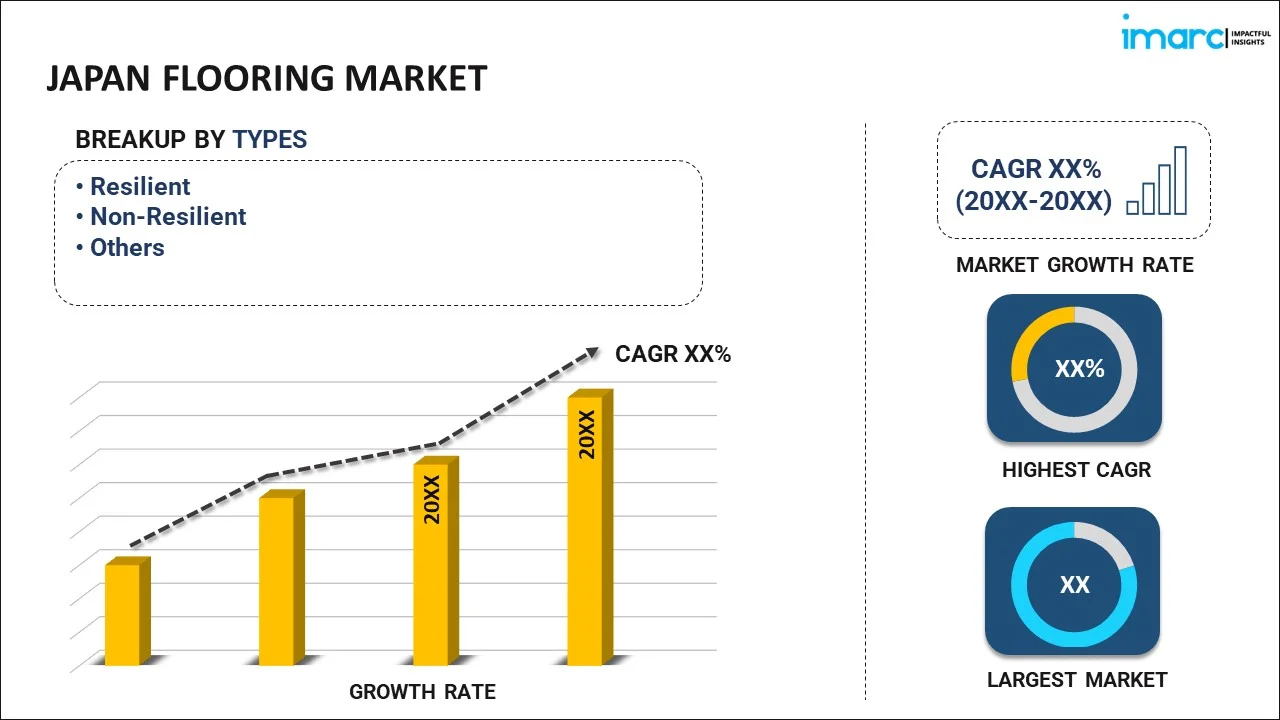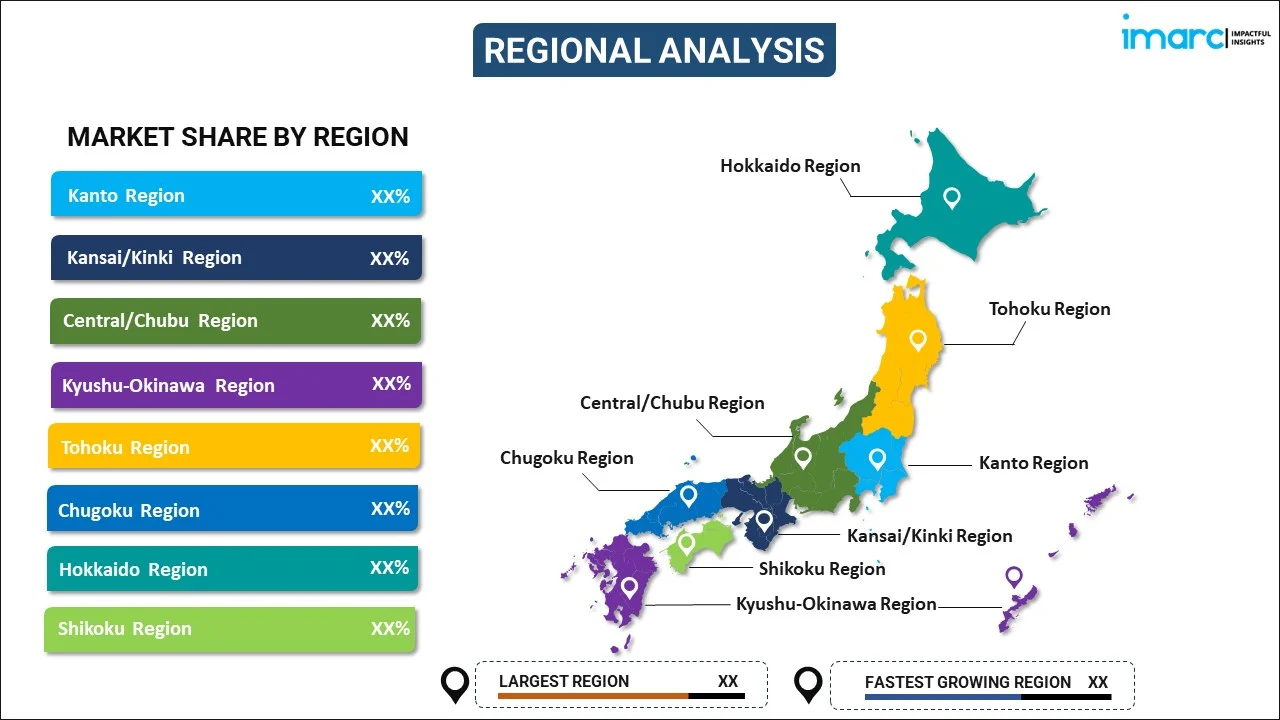
Japan Flooring Market Report by Type (Resilient, Non-Resilient, and Others), End User (Residential, Non-Residential), and Region 2026-2034
Market Overview:
Japan flooring market size reached USD 20.4 Billion in 2025. Looking forward, IMARC Group expects the market to reach USD 39.1 Billion by 2034, exhibiting a growth rate (CAGR) of 7.51% during 2026-2034. Strong urbanization, increased awareness of eco-friendly materials, an enhanced emphasis on interior aesthetics, development of luxury vinyl tiles (LVT) and hygiene-focused solutions, and government incentives for building renovations are factors contributing to the market's positive trajectory.
|
Report Attribute
|
Key Statistics
|
|---|---|
|
Base Year
|
2025 |
|
Forecast Years
|
2026-2034
|
|
Historical Years
|
2020-2025
|
| Market Size in 2025 | USD 20.4 Billion |
| Market Forecast in 2034 | USD 39.1 Billion |
| Market Growth Rate (2026-2034) | 7.51% |
Access the full market insights report Request Sample
Flooring refers to the material or covering that is installed on the floor of a building or space. It serves as the foundation for the interior of a structure and plays a crucial role in defining the overall aesthetics, functionality, and comfort of a space. One of the key advantages of flooring is its ability to enhance the visual appeal of a space. Well-chosen flooring can create a visually pleasing and cohesive design scheme, adding to the overall ambiance of a room. Additionally, it is a vital element in interior design, as it sets the tone for the entire space, influencing color palettes and decor choices. It is designed to withstand the demands of different environments and usage patterns. It is durable and resistant to wear and tear, making it suitable for high-traffic areas in both residential and commercial settings. Flooring materials are chosen based on their specific uses, with considerations, such as moisture resistance, ease of cleaning, and slip resistance being critical factors. Furthermore, it serves a functional purpose by providing insulation and soundproofing. It helps maintain a comfortable indoor temperature, ensuring that the space remains warm in colder seasons and cool during hot weather. Currently, various flooring options are available, including hardwood, laminate, tile, carpeting, and vinyl/linoleum in commercial spaces.
Japan Flooring Market Trends:
The Japan flooring market is influenced by several key drivers, such as the strong urbanization and population density in the country, which have led to a surge in construction activities, both residential and commercial. Additionally, the growing awareness about the importance of sustainable and eco-friendly building materials has resulted in a preference for flooring options that are environmentally friendly, such as bamboo and cork flooring, which is fueling the market growth. Moreover, the influence of Japanese culture and aesthetics places a strong emphasis on the quality and design of interior spaces, further driving the demand for high-end and visually appealing flooring solutions, which is propelling the market growth. Furthermore, the introduction of innovative flooring technologies, including luxury vinyl tiles (LVT) and hybrid flooring, has offered consumers a wider range of options to choose from, contributing to market growth. Additionally, the impact of the COVID-19 pandemic has led to an increased demand for hygienic and easy-to-clean flooring materials, such as antimicrobial and waterproof flooring, to ensure safety and maintainability, which is stimulating the market growth. Additionally, government initiatives promoting the renovation of older buildings have spurred demand for flooring replacement, further favoring the market expansion in the country.
Japan Flooring Market Segmentation:
IMARC Group provides an analysis of the key trends in each segment of the market, along with forecasts at the country level for 2026-2034. Our report has categorized the market based on type and end user.
Type Insights:

To get detailed segment analysis of this market Request Sample
- Resilient
- Non-Resilient
- Others
The report has provided a detailed breakup and analysis of the market based on the type. This includes resilient, non-resilient, and others.
End User Insights:
- Residential
- Non-Residential
A detailed breakup and analysis of the market based on the end user have also been provided in the report. This includes residential and non-residential.
Regional Insights:

To get detailed regional analysis of this market Request Sample
- Kanto Region
- Kansai/Kinki Region
- Central/ Chubu Region
- Kyushu-Okinawa Region
- Tohoku Region
- Chugoku Region
- Hokkaido Region
- Shikoku Region
The report has also provided a comprehensive analysis of all the major regional markets, which include Kanto Region, Kansai/Kinki Region, Central/ Chubu Region, Kyushu-Okinawa Region, Tohoku Region, Chugoku Region, Hokkaido Region, and Shikoku Region.
Competitive Landscape:
The market research report has also provided a comprehensive analysis of the competitive landscape. Competitive analysis such as market structure, key player positioning, top winning strategies, competitive dashboard, and company evaluation quadrant has been covered in the report. Also, detailed profiles of all major companies have been provided.
Japan Flooring Market Report Coverage:
| Report Features | Details |
|---|---|
| Base Year of the Analysis | 2025 |
| Historical Period | 2020-2025 |
| Forecast Period | 2026-2034 |
| Units | Billion USD |
| Scope of the Report | Exploration of Historical and Forecast Trends, Industry Catalysts and Challenges, Segment-Wise Historical and Predictive Market Assessment:
|
| Types Covered | Resilient, Non-Resilient, Others |
| End Users Covered | Residential, Non-Residential |
| Regions Covered | Kanto Region, Kansai/Kinki Region, Central/ Chubu Region, Kyushu-Okinawa Region, Tohoku Region, Chugoku Region, Hokkaido Region, Shikoku Region |
| Customization Scope | 10% Free Customization |
| Post-Sale Analyst Support | 10-12 Weeks |
| Delivery Format | PDF and Excel through Email (We can also provide the editable version of the report in PPT/Word format on special request) |
Key Questions Answered in This Report:
- How has the Japan flooring market performed so far and how will it perform in the coming years?
- What has been the impact of COVID-19 on the Japan flooring market?
- What is the breakup of the Japan flooring market on the basis of type?
- What is the breakup of the Japan flooring market on the basis of end user?
- What are the various stages in the value chain of the Japan flooring market?
- What are the key driving factors and challenges in the Japan flooring?
- What is the structure of the Japan flooring market and who are the key players?
- What is the degree of competition in the Japan flooring market?
Key Benefits for Stakeholders:
- IMARC’s industry report offers a comprehensive quantitative analysis of various market segments, historical and current market trends, market forecasts, and dynamics of the Japan flooring market from 2020-2034.
- The research report provides the latest information on the market drivers, challenges, and opportunities in the Japan flooring market.
- Porter's five forces analysis assist stakeholders in assessing the impact of new entrants, competitive rivalry, supplier power, buyer power, and the threat of substitution. It helps stakeholders to analyze the level of competition within the Japan flooring industry and its attractiveness.
- Competitive landscape allows stakeholders to understand their competitive environment and provides an insight into the current positions of key players in the market.
Need more help?
- Speak to our experienced analysts for insights on the current market scenarios.
- Include additional segments and countries to customize the report as per your requirement.
- Gain an unparalleled competitive advantage in your domain by understanding how to utilize the report and positively impacting your operations and revenue.
- For further assistance, please connect with our analysts.
 Request Customization
Request Customization
 Speak to an Analyst
Speak to an Analyst
 Request Brochure
Request Brochure
 Inquire Before Buying
Inquire Before Buying




.webp)




.webp)












